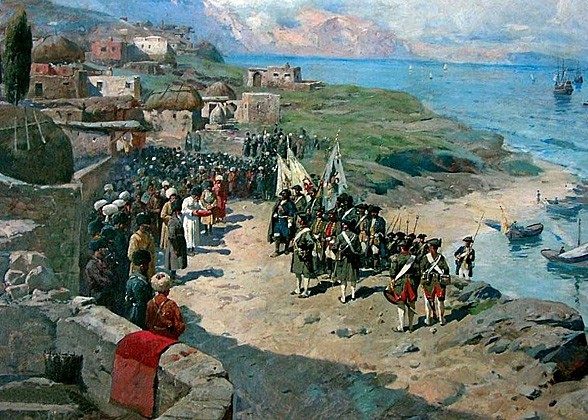… The Armenian dreams of state-building in the South Caucasus first appeared in late XVI – early XVII centuries. The existence of Church of Echmiadzin in this area made the Armenians focus on and directed all their attention to the Erivan khanate and adjacent territories as they considered the area as sacred.
The Armenians were granted some privileges during the Safavid period as they played an important role in the development of foreign trade. These privileges generated a desire of the Armenians to establish a state. Taking advantage of their role in the increase foreign trade policy of the Safavids, they sought support from European states.
The Armenian clergy and merchants held meetings in France, Prussia and Italy, while tried to maintain the relations with the Safavid ruler Shah Abbas. Thanks to their reputation earned at Safavid court, they began to hold important positions in the state`s foreign policy. However, the Armenians did not get the support they wanted due to the good relations between Europe and the Safavids.
The desires of the Armenians on state-building coincided with Russia`s interests in the region. Taking this into consideration, the Armenians began soon seeking support from Russia.
Starting from XVII century, Tsarist Russia conducted a foreign policy aimed at reaching warm seas. The Armenians became the center in Russia`s plans to conquest the Caucasus and to establish a Christian state in Azerbaijani lands against the Ottoman Empire and Iran. When the Russian Tsar Peter the Great was about to set relevant plans, Israel Ori of Armenian origin came to him with a map of “Great Armenia”. This visit marked the beginning of the four-phase settlement of Armenians in the Caucasus. The main goal of the first phase covering the years 1722-1887 was to resettle the Armenians living in Iran and Ottoman Empire to Azerbaijani territories and to artificially increase their number by resettling them in fertile lands.
The Armenians were first settled by the decree of Peter the Great in 1724 in the territories along the Caspian Sea – Mazandaran, Gilan, Baku and Derbent. The mass resettlement of the Armenians from the Ottoman Empire and Iran to Erivan, Nakhchivan and Karabakh continued in the aftermath of the 1828 Treaty of Turkmenchay and 1829 Treaty of Edirne.
With the help of Tsarist Russia, the Armenians increased their population in the region, introduced themselves as poor but capable people, “won” the trust of local people, improved their economic situation, and expanded their territory. Thus, the demographic situation in the region changed as a result of the policy of Tsarist Russia.
The second stage is the organizational phase (1887-1918). With the influence of the revolutions in West Europe and Russia, Armenians began to organize in the 1880-90s. The Armenian nationalists established Hunchak in Geneva in 1887, Dashnaksutyun in Tbilisi in 1890. Together with the Armenians living within the borders of Russia and the Ottoman Empire, these parties started functioning to build Great Armenia. The scope of the activities of the Armenian nationalist parties, particularly Dashnaksutyun included South Caucasus, Anatolian and European territories of the Ottoman Empire, as well as the Iranian territories inhabited by Azerbaijani Turks.
After the invasion of the South Caucasus by the Russian Empire, the organized Armenians carried out first acts of mass destruction and terror against Azerbaijani Turks in 1905-1907. The bloody acts were continued in 1918-1920; as a result, tens of thousands of Azerbaijanis were murdered, while hundreds of thousands of people became displaced.
The third phase covers the period of 1918-1988. The main line of the Armenian policy at this stage was aimed at driving all non-Armenians out and establishing a mono-ethnic Armenian state. Founded in May 1918, the Republic of Armenia had no capital. The Azerbaijan Democratic Republic gave its consent to yield Erivan to Armenia as a capital city if the Armenian terror organizations ceased their activities. After the Azerbaijani provinces of Zangezur and Goycha were given y the Bolshevist Russia to Armenia as a gift, the area of the Republic of Armenia rose from 9,000 square kilometers to 29,000 square kilometers.
C.Vəliyevin “Ermənilərin məskunlaşma strategiyası və Xocalı soyqırımı” məqaləsindən (“Strateji təhlil” jurnalı, №1, 2010)
From the article “Settlement strategy of Armenians and Khojali genocide” by J. Valiyev (Strateji tehlil journal, №1, 2010)











 Inauguration ceremony of President of Azerbaijan Ilham Aliyev was held
Inauguration ceremony of President of Azerbaijan Ilham Aliyev was held Ilham Aliyev wins presidential election with 92.05 percent of votes VIDEO
Ilham Aliyev wins presidential election with 92.05 percent of votes VIDEO President Ilham Aliyev, First Lady Mehriban Aliyeva and family members voted in Khankendi VIDEO
President Ilham Aliyev, First Lady Mehriban Aliyeva and family members voted in Khankendi VIDEO Plenary session of 6th Summit of Conference on Interaction and Confidence Building Measures in Asia gets underway in Astana. President Ilham Aliyev attends the plenary session VIDEO
Plenary session of 6th Summit of Conference on Interaction and Confidence Building Measures in Asia gets underway in Astana. President Ilham Aliyev attends the plenary session VIDEO President Ilham Aliyev was interviewed by Azerbaijani TV channels in Prague VIDEO
President Ilham Aliyev was interviewed by Azerbaijani TV channels in Prague VIDEO














